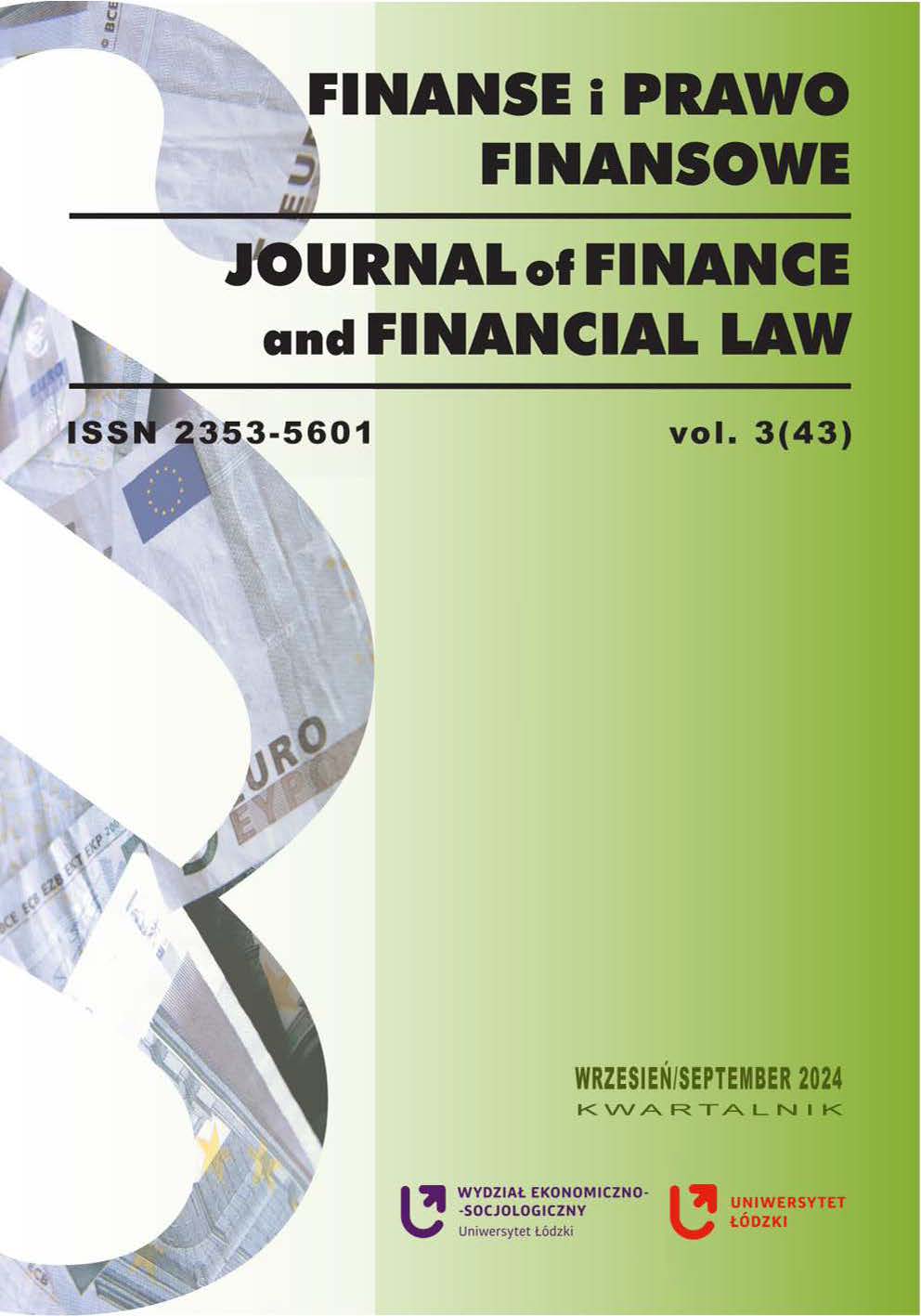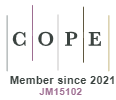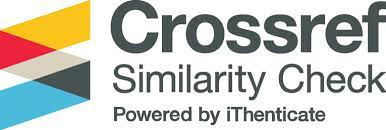Paytech as a Segment of Cashless Payments in Poland – Status and Development Prospects
DOI:
https://doi.org/10.18778/2391-6478.3.43.03Keywords:
PayTech, FinTech, mobile payments, paymentsAbstract
The purpose of the article. The article aims to present the state of development of the PayTech sector in Poland and analyze the prospects for its development. The authors examine whether the Polish PayTech sector is sufficiently developed to expand to the entire European Union, also identifying alternative directions of development and obstacles to the expansion of Polish payment systems, mainly the BLIK system.
Methodology. The methodology of the article is based on the analysis of the literature on the subject, mainly based on research available in the Google Scholar database. The authors use the work of researchers and financial institutions to present a picture of the PayTech sector in Poland. The literature review also includes NBP reports and analyzes as well as opinions of experts in the field of finance and technology.
Results of the research. The PayTech sector in Poland has great development potential due to the growing number of electronic payments and the planned expansion of the BLIK system to other countries. New technologies such as blockchain bring significant benefits to the PayTech sector, including data decentralization and increased transaction security. The PSD2 directive opened the financial market for the FinTech sector, which may increase the innovativeness of the PayTech sector and increase its competitiveness. Payment systems in Poland, such as BLIK, compete with traditional banks and may also have transnational potential. The increasing popularity of cashless payments in Poland is the result of the COVID-19 pandemic and the rising costs of using cash.
Methodology. The methodology of the article is based on the analysis of the literature on the subject, mainly based on research available in the Google Scholar database. The authors use the work of researchers and financial institutions to present a picture of the PayTech sector in Poland. The literature review also includes NBP reports and analyzes as well as opinions of experts in the field of finance and technology.
Results of the research. The PayTech sector in Poland has great development potential due to the growing number of electronic payments and the planned expansion of the BLIK system to other countries. New technologies such as blockchain bring significant benefits to the PayTech sector, including data decentralization and increased transaction security. The PSD2 directive opened the financial market for the FinTech sector, which may increase the innovativeness of the PayTech sector and increase its competitiveness. Payment systems in Poland, such as BLIK, compete with traditional banks and may also have transnational potential. The increasing popularity of cashless payments in Poland is the result of the COVID-19 pandemic and the rising costs of using cash.
Downloads
References
Arslanian, H. i Fischer, F. (2019). The future of finance: The impact of FinTech, AI, and crypto on financial services. Springer.
Google Scholar
DOI: https://doi.org/10.1007/978-3-030-14533-0
Autopay (2023). BLIK – metoda płatności, która deklasuje inne [BADANIE]. https://autopay.pl/baza-wiedzy/badania-i-raporty/blik-metoda-platnosci-deklasuje-inne-220709 [dostęp: 07.03.2024].
Google Scholar
Banaś, D. (2022). RegTech jako sposób poprawy efektywności instytucji rynku emerytalnego. Zeszyty Naukowe Politechniki Poznańskiej. Organizacja i Zarządzanie.
Google Scholar
Blik wchodzi do Rumunii, drugiego największego rynku Europy Środkowo-Wschodniej. MamStartup (2023). https://mamstartup.pl/blik-wchodzi-do-rumunii-drugiego-najwiekszego-rynku-europy-srodkowo-wschodniej/ [dostęp 07.03.2024].
Google Scholar
Chishti, S. (2020). The LegalTech Book: The Legal Technology Handbook for Investors, Entrepreneurs and FinTech Visionaries. John Wiley & Sons.
Google Scholar
Das, S.R. (2019). The future of fintech. Financial Management, 48(4): 981–1007.
Google Scholar
DOI: https://doi.org/10.1111/fima.12297
Derdziak, A. (2023). Co to jest blik i jak działa? Moneteo.com. https://moneteo.com/artykuly/blik
Google Scholar
Folwarski, M. (2018). Sektor bankowy i sektor FinTech – współpraca czy realne zagrożenie dla sektora bankowego. Prace Naukowe Uniwersytetu Ekonomicznego we Wrocławiu, 529, 84–94.
Google Scholar
DOI: https://doi.org/10.15611/pn.2018.529.07
Fosso Wamba, S., Kala Kamdjoug, J.R., Epie Bawack, R. i Keogh, J.G. (2020). Bitcoin, Blockchain and Fintech: A systematic review and case studies in the supply chain. Production Planning & Control, 31(2–3): 115–142.
Google Scholar
DOI: https://doi.org/10.1080/09537287.2019.1631460
Fundacja Polska Bezgotówkowa; Badania POLASIK; Narodowy Bank Polski (2023). Udział transakcji gotówkowych i bezgotówkowych w liczbie płatności detalicznych w Polsce w latach 2005–2022 [Wykres]. W: Statista. https://api.polskabezgotowkowa.pl/uploads/Zwyczaje_platnicze_Polakow_2022_POLASIK_Research_v20230802_07e6ddbe3c.pdf [dostęp 2.12.2023].
Google Scholar
Gawron, O. (2019). Otoczenie regulacyjne sektora fintech na przykładzie dyrektywy PSD2 i wybranych ustaw krajowych. Finanse i Prawo Finansowe, 4(24): 49–65.
Google Scholar
DOI: https://doi.org/10.18778/2391-6478.4.24.04
Grzywacz, J. i Jagodzińska-Komar, E. (2018). Rola banków i sektora FinTech w świetle implementacji dyrektywy PSD2. Kwartalnik Kolegium Ekonomiczno-Społecznego Studia i Prace, 2: 159–169.
Google Scholar
DOI: https://doi.org/10.33119/KKESSiP.2018.2.8
Hałasik-Kozajda, M. i Olbryś, M. (2021). Skutki implementacji dyrektywy o usługach płatniczych (PSD2). Bank i Kredyt, 52(3): 267–296.
Google Scholar
Hulicki, M. i Lustofin, P. (2017). Wykorzystanie koncepcji blockchain w realizacji zobowiązań umownych. Człowiek w cyberprzestrzeni, 1: 28–53.
Google Scholar
IMF; McKinsey & Company; World Bank; GlobalData; Worldpay (2023). Market share of cash, credit cards, and other payment methods at point of sale (POS) in Poland in 2017, 2019, 2020, 2021, and 2022 [Wykres]. In: Statista. https://www-1statista-1com-1s8fui2qx00a9.han3.ue.poznan.pl/statistics/1296907/preferred-payment-methods-poland/?fbclid=IwAR3FRVjKlj3GbVwl0oGkcxKb-zeMEa1FVcvfrmEDR_YPIV_H0LavlX8JbuLQ [dostęp 2.12.2023].
Google Scholar
Irimia-Diéguez, A., Albort-Morant, G., Oliver-Alfonso, M.D. and Ullah, S. (2023). Predicting the intention to use Paytech services by Islamic banking users. International Journal of Islamic and Middle Eastern Finance and Management, 17(1): 1–15.
Google Scholar
DOI: https://doi.org/10.1108/IMEFM-07-2022-0298
Iwańczuk-Kaliska, A. (2022). Rozdział 5. Bezgotówkowe płatności detaliczne w Polsce – rola banków i perspektywy rozwoju sektora PayTech. W: K. Waliszewski, red., Finanse Osobiste, PAN, 79–92. http://publikacje.pan.pl/Content/124153/PDF/2022-FINS-07-Iwanczuk.pdf [dostęp 7.03.2024].
Google Scholar
Iwańczuk-Kaliska, A., Marszałek, P., Schmidt, K. i Warchlewska, A. (2021). Ocena zmian na rynku płatności w Polsce. Raport Fundacji Warszawski Instytut Bankowości, Czerwiec.
Google Scholar
Jagodzińska-Komar, E. (2018). Płatności natychmiastowe w Polsce na przykładzie systemu blik. Nauki Ekonomiczne, t. XXVII.
Google Scholar
Judt, E. and Krueger, M. (2021). The European Payments Initiative: The next big thing in European payments? Journal of Payments Strategy & Systems, 15(3): 319–331.
Google Scholar
DOI: https://doi.org/10.69554/OTEO6959
Kasprowski, P., Ober, J. (2004). Eye movements in biometrics. In International Workshop on Biometric Authentication (pp. 248–258). Berlin, Heidelberg: Springer Berlin Heidelberg.
Google Scholar
DOI: https://doi.org/10.1007/978-3-540-25976-3_23
Kisiel, M. (2016). Modele interoperacyjności systemów płatności mobilnych – perspektywa polskiego rynku. Prace Naukowe Uniwersytetu Ekonomicznego we Wrocławiu, 462: 72–84.
Google Scholar
Kliber, F. (2022). Waluta cyfrowa Europejskiego Banku Centralnego jako instrument wspierania rozwoju energii odnawialnej (427–446). W: R. Bartkowiak, J. Ostaszewski, Z. Polański, red., System z Bretton Woods i jego dziedzictwo: od pieniądza złotego do cyfrowego. Warszawa: Oficyna Wydawnicza SGH.
Google Scholar
Kotkowski, R., Maciejewski, K. i Maicki, P. (2020). PayTech – Innowacyjne rozwiązania płatnicze na rynku polskim. Warszawa: Narodowy Bank Polski.
Google Scholar
Kotliński, G. (2018). Konsekwencje i determinanty wpływu innowacji informacyjnych na rynek pracy w obszarze pośrednictwa finansowego i w bankowości. Zeszyty Naukowe Polskiego Towarzystwa Ekonomicznego w Zielonej Górze, 5(8): 83–97.
Google Scholar
KPMG (2019). PSD2 i open banking – rewolucja czy ewolucja? KPMG.
Google Scholar
Król, P. (2024). Phishing jako zagrożenie dla bezpieczeństwa bankowości cyfrowej. Bezpieczny Bank, 94(1): 25–42. https://doi.org/10.26354/bb.2.1.94.2024
Google Scholar
Marchewka-Bartkowiak, K. (2018). Nowe rozwiązania regulacyjne – RIA, sandbox, compliance, RegTech – w świetle procesu „inflacji” prawa finansowego. Studia BAS, 1: 135–148.
Google Scholar
DOI: https://doi.org/10.31268/StudiaBAS.2019.04
Marciniak, A. (2019). Blik będzie zbliżeniowy Polski Standard Płatności i MasterCard zawarły partnerstwo. Mastercard. https://www.mastercard.com/news/europe/pl-pl/centrum-prasowe/aktualnosci/pl-pl/2019/pazdziernik/blik-bedzie-zblizeniowy-polski-standard-platnosci-i-mastercard-zawarly-partnerstwo/ [dostęp 7.03.2024].
Google Scholar
Marszałek, P. (2019). Kryptowaluty – pojęcie, cechy, kontrowersje. Studia BAS, 1: 105–125.
Google Scholar
DOI: https://doi.org/10.31268/StudiaBAS.2019.06
McConvey, J.R. (2023). Payeye dual biometrics win FIDO certification with Zero pad errors. Biometric Update | Biometrics News, Companies and Explainers. https://www.biometricupdate.com/202301/payeye-dual-biometrics-win-fido-certification-with-zero-pad-errors [dostęp 7.03.2024].
Google Scholar
Mętrak, T. (2023). Finansowanie społecznościowe w zakresie działalności pożyczkowej i inwestycyjnej. Zarys aktualnej sytuacji prawnej. Studia Prawno-Ekonomiczne, 128: 33–48.
Google Scholar
DOI: https://doi.org/10.26485/SPE/2023/128/2
Nilson (2024). Nilson Report Issue 1256, January 2024. https://fasterpaymentscouncil.org/userfiles/2080/files/Nilson%20Report_First%20Look_FPC_01-2024.pdf [dostęp 16.06.2024].
Google Scholar
Nowakowski, M. (2020). FinTech-technologia, finanse, regulacje. Praktyczny przewodnik dla sektora innowacji finansowych. Wolters Kluwer.
Google Scholar
Omieljanowicz, M. (2021). Zagadnienia segmentacji tęczówki na potrzeby systemów biometrycznych. W: W. Kwedlo, red., Wybrane zagadnienia informatyki technicznej. Eksploracja danych i biometria (46–67). https://doi.org/10.24427/978-83-66391-84-0_3
Google Scholar
PayPo (2023). Najpopularniejsze metody płatności podczas zakupów online w Polsce w 2022 roku [Wykres]. W: Statista. https://www-1statista-1com-1s8fui2qx001b.han3.ue.poznan.pl/statistics/1314661/poland-popular-payment-methods-when-shopping-online/ [dostęp 2.12.2023].
Google Scholar
Polak, E. (2021). Pandemia Covid-19 jako katalizator procesów inwigilacji i kontroli społecznej. Fides, Ratio et Patria. Studia Toruńskie, 14: 62–85.
Google Scholar
DOI: https://doi.org/10.56583/frp.643
Puschmann, T. (2017). Fintech. Business & Information Systems Engineering, 59: 69–76.
Google Scholar
DOI: https://doi.org/10.1007/s12599-017-0464-6
Ranking operatorów płatności online. Convertis. (2023). https://convertis.pl/ranking/ranking-operatorow-platnosci/ [dostęp 7.03.2024].
Google Scholar
Saeed, E., Konopińska, J., Mariak, Z. i Saeed, K. (2017). Wpływ chorób oczu na wzorzec siatkówki i tęczówki oraz znaczenie tego wzorca we wczesnej diagnostyce okulistycznej. Klinika Oczna, 119(1): 24–28.
Google Scholar
Schmidt-Jessa, K. (2021). Bank internetowy (digital-only bank) – nowy model bankowości. W: Innowacje finansowe w gospodarce 4.0 (pp. 104–119). Poznań: Wydawnictwo Uniwersytetu Ekonomicznego w Poznaniu.
Google Scholar
DOI: https://doi.org/10.18559/978-83-8211-083-8/6
Solarz, M. (2017). FinTech-innowacje w obszarze usług finansowych. Prace Naukowe Wyższej Szkoły Zarządzania i Przedsiębiorczości z siedzibą w Wałbrzychu, 43: 233–250.
Google Scholar
Solarz, J.K. i Waliszewski, K. (2022). Od dystansu społecznego do dezintermediacji usług finansowych i medycznych w czasie pandemii Covid-19. Zeszyty Naukowe Politechniki Śląskiej. Organizacja i zarządzanie, 160.
Google Scholar
Szpilko, D., Bazydło, D. i Bondar, E. (2021). Wpływ pandemii COVID-19 na zakres i jakość usług kurierskich. Wyniki badań wstępnych. Marketing i Rynek, 5: 11–22.
Google Scholar
DOI: https://doi.org/10.33226/1231-7853.2021.5.2
Takeda, A. i Ito, Y. (2021). A review of FinTech research. International Journal of Technology Management, 86(1): 67–88.
Google Scholar
DOI: https://doi.org/10.1504/IJTM.2021.115761
Tencent (2024). Weixin’s Palm Scan Payments Is Like Waving at a Friend. https://www.tencent.com/en-us/articles/2201785.html [dostęp 16.06.2024].
Google Scholar
Uryniuk, J. (2023). Władze PSP: Pracujemy nad Koncepcją Blik Euro. Chcemy Go Zaoferować wszystkim bankom w Europie. cashless.pl. https://www.cashless.pl/13100-blik-euro-rumunia-slowacja [dostęp 7.03.2024].
Google Scholar
Warchlewska, A., Janc, A. i Iwański, R. (2021). Finanse osobiste w dobie nowoczesnych rozwiązań technologicznych. Finanse i Prawo Finansowe, 29.
Google Scholar
Zibran, M.F. (2009). Eye based authentication: Iris and retina recognition. Department of Computer Science, The University of Saskatchewan, Canada, 7.
Google Scholar
Downloads
Published
How to Cite
Issue
Section
License

This work is licensed under a Creative Commons Attribution-NonCommercial-NoDerivatives 4.0 International License.














